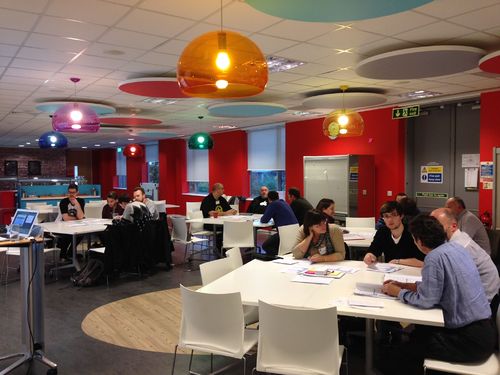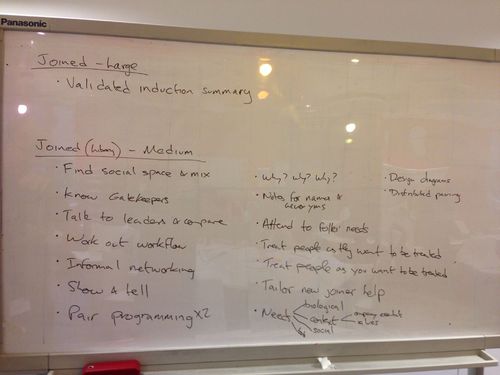WhereDoIStartMiniSPA
From SPA Wiki
Contents |
Where Do I Start
Andy Longshaw, Nick Rozanski, Eoin Woods.
Overview
Whatever level you work at in an organization it is challenging to become effective quickly when you first arrive.
In this session we looked at gathering a mixture of technical and non-technical practices that will help people to overcome this problem. For example, from a technical perspective, if there is no system architecture diagram it might be useful to create one, from a non-technical perspective you might want to make an organisational map of individuals and responsibilities.
The goal of the session was to draw on shared experience to reflect on what has worked for people in different contexts and to define a toolkit of techniques that people can try to apply in their own work environment.
The session ran as two iterations, indentifying and then refining practices for people to use. Most of the work concentrated on a software developer who is joining a new medium sized organisation.
Iteration 1
The initial long list of practices that people identified were:
- Produce a written version of the information from the induction process and have it validated by an experienced colleague
- Find the social spaces where people meet and go and have coffee and mix with them
- Know the gatekeepers to groups, knowledge, decisions and resources in the organisation
- Talk to different team leaders and compare what you learn from each
- Work out the workflow of work through the organisation
- Map out and create an informal network of people
- Organise "show and tell" sessions across groups and teams
- Do some pair programming
- Ask Why? Why? Why? ("Be a three year old")
- Keep copious notes for names and acronyms
- Attend to people's needs
- Treat people as you would like to be treated
- Treat people as they would like (or need) to be treated
- Tailor new joiner help to what people need to know
- Think about different needs of new joiners (biological, context, social, task related)
- Create design diagrams
- Pair across teams to get different perspectives
Iteration 2
In the second iteration, each of the 4 teams considered the consolidated long list and produced a short list of specific practices:
Team 1
- Collaborate
- Pair
- Shadow
- Validate
- Produce summaries and seek feedback on them
- find opportunities to fail cheaply
- validate your notes
- Chat
- Don't lunch at your desk
- Ask questions, even those that don't obviously need to be asked
Team 2
- Pair Programming
- ping, pong style working, hands on work
- Pros: reality of the practice, contribute from day 1
- Cons: scale of tasks important, team culture needs to be right
- First Impressions
- capture your impressions now, first impressions only happen once
- Pros: helps to retain initial impression, frees up mental space
- Cons: it can be time consuming, you will have gaps
Team 3
- Take active steps to find out how things are done in your new team
- hold interviews and discussions
- listen carefully
- take notes
- build up an overall picture
Team 4
- Pairing
- ask lots of questions
- pair with as many as possible
- Draw architecture diagrams
- present them back to the team
- Socialise
- get to know people early
- establish good relationships
These practices summarise nicely to PAIR -- ENQUIRE -- RECORD -- CONNECT which is great advice to bear in mind when joining a new organisation.
Outputs
The original outputs of the two iterations are shown below:

